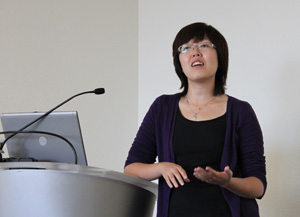Improving Electronic Medical Records
August 25, 2010 / By Anna Lynn Spitzer
|
Electronic medical records systems transform patient charts into legible, accessible and easy-to-share files. But a 2009 study found that only 1.5 percent of U.S. hospitals were using these systems.
In the remaining 97.5 percent of hospitals, it can take as long as 48 hours for a physician to retrieve medical charts when patients are admitted.
“It’s really hard to find information in a short time and stay efficient [with paper charts],” informatics assistant professor Yunan Chen told an audience gathered at this week’s SURF-IT lunchtime summer seminar.
Chen believes the majority of healthcare providers will adopt electronic medical records in the coming years, and she is seeking ways to make them more responsive.
She is particularly interested in the social implications of these systems and their impact on the clinical practice of medicine. Her most recent research is focused on the emergency department of a large hospital because “it’s an information-rich environment, everything moves really fast, it’s complex and there are multiple stakeholders,” she said.
Initially, her methodology involved detailed observations that occurred over the course of days, nights, weekdays and weekends. She surveyed the waiting room, the triage room, nursing and doctors’ stations, and patient rooms. In addition, she shadowed individual doctors and nurses to better understand their work flow and practices.
Chen noticed immediately that while computers were plentiful and easily accessible, most doctors and nurses chose to record information on paper notes and charts, which they later scanned or otherwise transferred into the electronic system.
These paper accounts, which she dubs “transitional artifacts,” did not end up filed away. Instead, they bridged the gap between clinical work and the formal EMR-based documentation, and were later discarded. Because Chen’s goal is to incorporate her findings into the design of future electronic systems, she wanted to learn why doctors and nurses relied on these transitional artifacts instead of entering data immediately on their computers.
She found the paper notes serve three distinct purposes: they help personnel document the sequence of events; they assist in tracking the completion of tasks; and they provide a working memory for doctors and nurses awaiting more information and/or diagnosis – all tasks the electronic system doesn’t permit. “It would be really interesting if the future systems could support these types of documentation activities,” Chen said.
Chen and her SURF-IT student, Steven Nguyen, are engaged in the next phase of the research, she told the audience. In an attempt to draw more quantitative information from the study, they are documenting nurses’ work practices in 14 categories every 15 minutes, and recording the time each task occurs. This process is known as “ecological momentary assessment” and is considered more systematic than pure observation. “The idea is to see how many times they do different tasks and how much time they spend, and how they move from one task to the other – the sequence of events,” she said.
“No one ever did this before … most research has either sampled the time or the task, but not both,” she added. “I think how people spend their time and how they do their tasks will benefit the medical informatics field.”
-- Anna Lynn Spitzer


